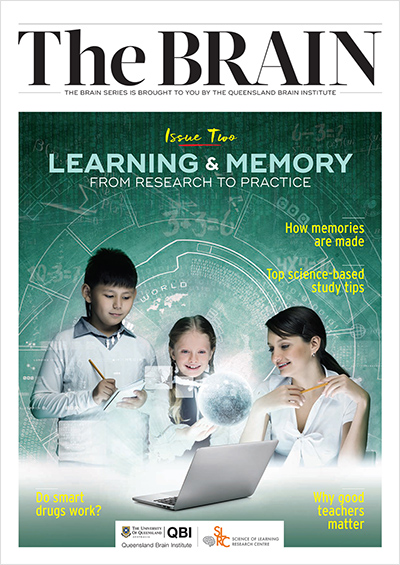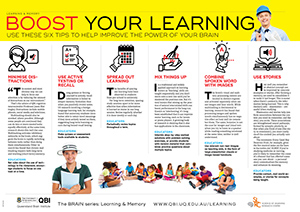Have you ever wondered why you can’t remember being a baby? Or why you can easily remember all the words to a song you learnt as a teenager—even if that was 20 (or more) years ago?
The answers to these questions may lie in the way our memory system develops as we grow from a baby to a teenager and into early adulthood. Our brain is not fully developed when we are born—it continues to grow and change during this important period of our lives. And, as our brain develops, so does our memory. Let’s wander down memory lane and take a look.
Memories: from birth to adolescence
Can you remember your first birthday? Your second? Adults rarely remember events from before the age of three, and have patchy memories when it comes to things that happened to them between the ages of three and seven. It’s a phenomenon known as ‘infantile amnesia’.
So why is it so hard to remember being a baby or toddler? Is it simply because our first, third, and even seventh birthdays happened a long time ago, and our memories have naturally faded? Not necessarily. In fact, a 40-year-old adult will usually have very strong memories of adolescence (more about that later) which, for them, happened more than 20 years ago. A 15-year-old, on the other hand, will be unlikely to remember something that occurred when they were two, even though it happened only 13 years ago.
What do babies remember?
It used to be thought that the reason we can’t remember much of our early childhood is because, as young children, we just aren’t able to make stable memories of events. You can’t access a memory, the logic goes, if it’s not there!
But it turns out that infants and small children can and do form memories. This includes both implicit memories (such as procedural memories, which allow us to carry out tasks without thinking about them) and explicit memories (like when we consciously remember an event that happened to us).
Our ability to remember things for long periods of time does, however, progressively get better throughout childhood. In experiments in which young children were taught to imitate an action, for example, six-month-olds could remember what to do for 24 (but not 48) hours, while nine-month-olds could remember what to do one month (but not three months) later. By 20 months of age, infants could still remember how to do a task which they were shown a whole year earlier.
Interestingly, recent research in rats has revealed that, despite the apparent loss of early episodic memories, a latent trace of the memory of an early experience remains for a long period of time—and can be triggered by a later reminder. This may explain why early trauma can influence adult behaviour and increase the risk of future mental disorders.
Our changing brain
Neuroscientists studying memory in animals (such as rats and monkeys) have discovered that it’s not just people who experience infantile amnesia. It seems to be common to animals whose brains, like ours, keep developing after they’re born.
At birth, a human baby’s brain is only a quarter of its adult size. By the age of two, it’ll be three-quarters of the size of an adult brain. This change in size correlates with the growth of neurons and the testing and pruning of connections (more about that later). So what does the fact that our brains are still developing in infancy and early childhood mean for our memories?
Let’s take a look at the hippocampus—that part of the brain which is especially important in the formation of episodic memories (memories of events that happened to us). While many parts of the brain keep developing and changing after we’re born, it’s one of only a few regions that keeps producing new neurons into adulthood. When we’re little, for example, a part of the hippocampus called the dentate gyrus is in overdrive, making neurons at a great rate. These new neurons are then integrated into hippocampal circuits. Although the production of new neurons continues in adulthood, the rate of activity slows down.
Scientists think that this rapid rate of neuron production in childhood could contribute to our higher rate of forgetting when we’re young. How? By forming new connections with memory circuits, the masses of new neurons may disrupt existing networks of already-formed memories.
Memory in the teenage years
While early childhood has long been recognised as an important time for brain development, it used to be thought that it was all over long before we hit puberty. But it’s now known that our brain keeps developing and changing during puberty and adolescence. In particular, our prefrontal cortex, which is important for executive functions like controlling our behaviour, shows important changes at this time. And, as these areas of our brain continue to change and develop, so does our memory.
The reminiscence bump
The words to a corny love song, the moves to the Macarena, even the boring, everyday stuff—if it was part of our adolescence, we’re more likely to remember it 20, 30 or even 40 years later. A number of studies have shown that adults over the age of about 30 have more memories from adolescence and early adulthood than from any other time of their lives, before or after—a phenomenon known as the ‘reminiscence bump’.
It’s thought that this is because, when we form a new self-image, we encode robust and lasting memories that are relevant to that self. In other words, we are most likely to favour memories that reinforce our ideas of who we are. Since adolescence is a key time for the emergence of a stable and enduring self, it’s also the period we tend to remember most strongly.
More myelin into the teenage years
You’ve probably heard of ‘grey matter’. Often used as a kind of shorthand for the cells of the brain, grey matter is largely composed of densely packed neurons.
But go beneath this ‘topsoil’ of the brain and you’ll discover, filling nearly half of it, a mass of communication cables (axons) which connect neurons in different parts of the brain. This is white matter. The cables are coated in a fatty substance called myelin, which give them the white colour that shows up on an MRI. Myelin acts like insulation around the axons, allowing messages (in the form of electrical signals) to be carried more quickly between areas of the brain. The more myelin, the quicker the messages will travel.
Thanks to MRI technology, scientists have been able to observe what happens to myelin in our brains during childhood and adolescence. They’ve found that, while sensory and motor brain regions become fully myelinated (coated in myelin) in first few years of life, myelination in our frontal cortex continues well into adolescence.
Synaptic growth and trimming at puberty
In our first few months of life, our brains get busy making lots and lots of synapses (connections between neurons), until we end up with many more than we’ll eventually have as adults. Over the following few years, these connections are gradually pruned. Depending on our experiences, some connections are strengthened while others disappear until, eventually, the density of our synapses reaches adult levels.
But, in our prefrontal cortex, it seems that this happens a second time. As we hit puberty, corresponding with a turbulent time of growth and learning in the rest of the body, there is another wave of synaptic proliferation in the brain. Then, as we move through adolescence, these connections are again pruned back and reorganised. This pruning makes the existing connections more efficient, so it’s essential to cognitive processes such as memory.
Because our frontal and prefrontal cortex continue to develop in these ways during puberty and adolescence, we might expect to see a corresponding improvement in executive functions to do with memory which are associated with these frontal regions of our brain. And indeed, this has been found to be the case: experiments have shown that our performance on complex working memory tasks continues to improve in adolescence, as does our prospective memory (our ability to remember to do things in the future).
Memory milestones from birth to adulthood
- Birth – 1
-
- ability to remember events for short periods of time (length of time gradually increases)
- 1 – 2
-
- ability to remember events for longer and longer amounts of time
- 2 – 3 years
-
- declarative memory (memory for facts and events) improves
- 4 – 7 years
-
- prospective memory (remembering to do things in the future) starts to emerge
- 8 – 10 years
-
- improved recall of facts
- improved recall of spatial relationships
- 10 – 12 years
-
- long-term memory improves
- increasing ability to consciously supress memories
- 13 – 21 years
-
- prospective memory improves
- working memory improves
Authors
Dr Keori Ikeda, science policy officer, Australian Brain Alliance
Hayley Teasdale, PhD student, University of Canberra
Article is republished with permission from www.nova.org.au.


